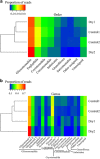Local diversity of heathland Cercozoa explored by in-depth sequencing
- PMID: 26953604
- PMCID: PMC5030685
- DOI: 10.1038/ismej.2016.31
Local diversity of heathland Cercozoa explored by in-depth sequencing
Abstract
Cercozoa are abundant free-living soil protozoa and quantitatively important in soil food webs; yet, targeted high-throughput sequencing (HTS) has not yet been applied to this group. Here we describe the development of a targeted assay to explore Cercozoa using HTS, and we apply this assay to measure Cercozoan community response to drought in a Danish climate manipulation experiment (two sites exposed to artificial drought, two unexposed). Based on a comparison of the hypervariable regions of the 18S ribosomal DNA of 193 named Cercozoa, we concluded that the V4 region is the most suitable for group-specific diversity analysis. We then designed a set of highly specific primers (encompassing ~270 bp) for 454 sequencing. The primers captured all major cercozoan groups; and >95% of the obtained sequences were from Cercozoa. From 443 350 high-quality short reads (>300 bp), we recovered 1585 operational taxonomic units defined by >95% V4 sequence similarity. Taxonomic annotation by phylogeny enabled us to assign >95% of our reads to order level and ~85% to genus level despite the presence of a large, hitherto unknown diversity. Over 40% of the annotated sequences were assigned to Glissomonad genera, whereas the most common individually named genus was the euglyphid Trinema. Cercozoan diversity was largely resilient to drought, although we observed a community composition shift towards fewer testate amoebae.
Figures



Similar articles
-
New barcoded primers for efficient retrieval of cercozoan sequences in high-throughput environmental diversity surveys, with emphasis on worldwide biological soil crusts.Mol Ecol Resour. 2018 Mar;18(2):229-239. doi: 10.1111/1755-0998.12729. Epub 2017 Nov 20. Mol Ecol Resour. 2018. PMID: 29058814
-
Response of forest soil euglyphid testate amoebae (Rhizaria: Cercozoa) to pig cadavers assessed by high-throughput sequencing.Int J Legal Med. 2016 Mar;130(2):551-62. doi: 10.1007/s00414-015-1149-7. Epub 2015 Jan 27. Int J Legal Med. 2016. PMID: 25874666
-
New genera, species, and improved phylogeny of Glissomonadida (Cercozoa).Protist. 2011 Nov;162(5):710-22. doi: 10.1016/j.protis.2011.06.002. Epub 2011 Jul 23. Protist. 2011. PMID: 21783412
-
A new phylogeny and environmental DNA insight into paramyxids: an increasingly important but enigmatic clade of protistan parasites of marine invertebrates.Int J Parasitol. 2016 Sep;46(10):605-19. doi: 10.1016/j.ijpara.2016.04.010. Epub 2016 Jun 25. Int J Parasitol. 2016. PMID: 27354180 Review.
-
The Vampyrellid Amoebae (Vampyrellida, Rhizaria).Protist. 2022 Feb;173(1):125854. doi: 10.1016/j.protis.2021.125854. Epub 2021 Dec 17. Protist. 2022. PMID: 35091168 Review.
Cited by
-
The Diversity Patterns of Rare to Abundant Microbial Eukaryotes Across a Broad Range of Salinities in a Solar Saltern.Microb Ecol. 2022 Nov;84(4):1103-1121. doi: 10.1007/s00248-021-01918-1. Epub 2021 Nov 15. Microb Ecol. 2022. PMID: 34779881 Free PMC article.
-
Ecological clusters of soil taxa within bipartite networks are highly sensitive to climatic conditions in global drylands.Philos Trans R Soc Lond B Biol Sci. 2022 Aug 15;377(1857):20210387. doi: 10.1098/rstb.2021.0387. Epub 2022 Jun 27. Philos Trans R Soc Lond B Biol Sci. 2022. PMID: 35757878 Free PMC article.
-
Bacterial and protozoan dynamics upon thawing and freezing of an active layer permafrost soil.ISME J. 2019 May;13(5):1345-1359. doi: 10.1038/s41396-019-0351-x. Epub 2019 Jan 28. ISME J. 2019. PMID: 30692629 Free PMC article.
-
Patterns of protist diversity associated with raw sewage in New York City.ISME J. 2019 Nov;13(11):2750-2763. doi: 10.1038/s41396-019-0467-z. Epub 2019 Jul 9. ISME J. 2019. PMID: 31289345 Free PMC article.
-
Genetic Diversity, Community Assembly, and Shaping Factors of Benthic Microbial Eukaryotes in Dongshan Bay, Southeast China.Front Microbiol. 2020 Dec 23;11:592489. doi: 10.3389/fmicb.2020.592489. eCollection 2020. Front Microbiol. 2020. PMID: 33424795 Free PMC article.
References
-
- Altschul SF, Gish W, Miller W, Myers EW, Lipman DJ. (1990). Basic local alignment search tool. J Mol Biol 215: 403–410. - PubMed
-
- Baldauf SL, Roger A, Wenk-Siefert I, Doolittle W. (2000). A kingdom-level phylogeny of eukaryotes based on combined protein data. Science 290: 972–977. - PubMed
-
- Bamforth SS. (1995). Interpreting soil ciliate biodiversity. Plant Soil 170: 159–164.
-
- Bass D, Cavalier-Smith T. (2004). Phylum-specific environmental DNA analysis reveals remarkably high global biodiversity of Cercozoa (Protozoa). Int J Syst Evol Micr 54: 2393–2404. - PubMed
MeSH terms
Substances
LinkOut - more resources
Full Text Sources
Other Literature Sources

